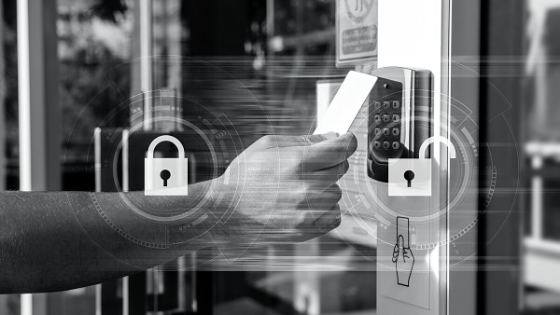Access control is fast-becoming a must-have front line defence for businesses to protect their staff, assets and property. The best commercial security consists of multiple layers, with access control being the first of these, providing a solid foundation on which all other elements are built.
What is access control?
As the name suggests, access control is a method by which only those with the relevant authorisation can enter a premises or certain areas of a facility. It provides accurate monitoring not only of who enters, but the time they do so, the exact place of entry, as well as the time and place of egress. This is managed through electronic or biometric recognition, such as an access card, key fob, fingerprint or even facial recognition.

As technology continues to advance, other methods of authorisation will become more commonplace.
Advantages of access control
Apart from the obvious – that of providing selective access to a building or particular areas – access control systems offer major benefits to business premises of all sizes.
- Provides a complete record of everyone who enters a facility, including dates, times, and habitual behaviour.
- The ability to see who’s attempted to access an area to which they don’t have authorisation.
- Different permissions can easily be assigned to individuals/areas/times of access.
- Specific areas or a whole building can be immediately shut down should the situation warrant it.
- Negates the need to supply individuals with keys, and the increased risk this brings for these to be copied and/or fall into unauthorised hands.
- In the event of an emergency there’s a real-time and complete list of who’s on the premises.
Access control is suitable for all types of business locations, such as:
- Manufacturing and industrial facilities
- Financial institutions
- Multi-tenant residential properties
- Assisted living and healthcare facilities
- Transportation and commerce sites, such as airports, bus and rail terminals, marinas etc.
- Hotels and resorts
- Educational facilities
- Shopping centres and commercial facilities.
Additional layers and integration
It’s important to realise that the installation of an access control system is only the first level of security. There are multiple additional layers that can be integrated within the system to effectively ring-fence the facility, depending on individual needs.
Examples include:
- CCTV/Security cameras: Cameras can be programmed to record should a critical incident occur, such as unauthorised access, a break-in or vandalism to property.
- Immediate building lockdown: In the case of an emergency.
- Integration to safety features: Including fire alarms, intrusion detection alerts, electrical incidents etc.
- Entry point security: Such as intercoms and chat features, turnstile control, wireless locks…
- Biometrics: Such as facial recognition, fingerprints, temperature control.
- Energy saving: Manage lights, heating and other electrical features in various areas in line with occupancy.
Proactive security
The installation of an access control system is to take a proactive, as opposed to reactive, approach towards business security. While features such as video and CCTV are, of course, stalwarts of any good commercial security formula, access control should be considered the first line of defence in that it can actively prevent breaches occurring in the first place.
Quite simply, access control is the founding base from which all additional security methods are built upon, affording a bespoke, robust solution for any size of business.
Perth-based Crown Security are leading providers of the ultimate in access control and all additional aspects of business security. From the simplest of entry systems to corporate installations over multiple sites, their expert security analysis determines the ultimate facilities that suit individual installations.



















